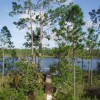 Conservation easements are cost-effective means for government agencies or non-government conservation organizations to protect land. Instead of purchasing land outright, these agreements allow organizations to purchase the development rights of a property. This protects the land and saving money. Landowners who choose this option prevent future residential and commercial development of their land, and reduce the amount of inheritance tax liability. Landowners are encouraged to enter such agreements carefully because they require several rights to be conveyed to the easement grantee and the duration of these agreements is typically perpetual. This 5-page fact sheet describes conservation easements, what is involved in establishing one, tax implications, participating government and non-government organizations, and important considerations for landowners. Written by Chris Demers and Douglas R. Carter, and published by the UF Department of School of Forest Resources and Conservation, March 2014.
Conservation easements are cost-effective means for government agencies or non-government conservation organizations to protect land. Instead of purchasing land outright, these agreements allow organizations to purchase the development rights of a property. This protects the land and saving money. Landowners who choose this option prevent future residential and commercial development of their land, and reduce the amount of inheritance tax liability. Landowners are encouraged to enter such agreements carefully because they require several rights to be conveyed to the easement grantee and the duration of these agreements is typically perpetual. This 5-page fact sheet describes conservation easements, what is involved in establishing one, tax implications, participating government and non-government organizations, and important considerations for landowners. Written by Chris Demers and Douglas R. Carter, and published by the UF Department of School of Forest Resources and Conservation, March 2014.
http://edis.ifas.ufl.edu/fr149
Tag: Estate Planning
Estate Planning (FCS7207/FY446)
 Estate planning has to do with living, not just with decisions about who inherits property. An estate plan is a pattern, a guide, or a master method for working toward financial security and the family’s future welfare. To be most effective, estate planning should involve all members of the family. The objectives of estate planning will differ among families because of varying circumstances, such as differences in assets, value judgments, personal desires, and number of children. Consider these purposes for estate planning. This 7-page fact sheet was written by Martie Gillen, Josephine Turner, and Vervil Mitchell, and published by the UF Department of Family Youth and Community Sciences, March 2012.
Estate planning has to do with living, not just with decisions about who inherits property. An estate plan is a pattern, a guide, or a master method for working toward financial security and the family’s future welfare. To be most effective, estate planning should involve all members of the family. The objectives of estate planning will differ among families because of varying circumstances, such as differences in assets, value judgments, personal desires, and number of children. Consider these purposes for estate planning. This 7-page fact sheet was written by Martie Gillen, Josephine Turner, and Vervil Mitchell, and published by the UF Department of Family Youth and Community Sciences, March 2012.
http://edis.ifas.ufl.edu/fy446
Estate Planning: Your Will (FCS5241/FY540)
 A will is considered to be the cornerstone of most estate plans. A will is a written legal document that takes effect at death, and is used to administer the estate, including transferring property ownership and making provisions for the care of minor or dependent children. This 4-page fact sheet was written by Martie Gillen and Josephine Turner, and published by the UF Department of Family Youth and Community Sciences, March 2012. http://edis.ifas.ufl.edu/fy540
A will is considered to be the cornerstone of most estate plans. A will is a written legal document that takes effect at death, and is used to administer the estate, including transferring property ownership and making provisions for the care of minor or dependent children. This 4-page fact sheet was written by Martie Gillen and Josephine Turner, and published by the UF Department of Family Youth and Community Sciences, March 2012. http://edis.ifas.ufl.edu/fy540
Estate Planning: Getting Started (FCS5239/FY538)
 Estate planning is a topic avoided by many people because it deals with attitudes and feelings about death, property ownership, business arrangements, marriage, and family relationships that family members may not be ready to discuss. It may also be avoided because family members disagree on how assets are to be handled. Although planning for the end of life may be uncomfortable, think of it as a gift to your family. By getting your affairs in order, you will save them a great deal of anxiety, time, and money even if you can’t spare them their grief. This 5-page fact sheet is the first in a series on estate planning tools and techniques. Written by Josephine Turner and Martie Gillen, and published by the UF Department of Family Youth and Community Sciences, December 2011.
Estate planning is a topic avoided by many people because it deals with attitudes and feelings about death, property ownership, business arrangements, marriage, and family relationships that family members may not be ready to discuss. It may also be avoided because family members disagree on how assets are to be handled. Although planning for the end of life may be uncomfortable, think of it as a gift to your family. By getting your affairs in order, you will save them a great deal of anxiety, time, and money even if you can’t spare them their grief. This 5-page fact sheet is the first in a series on estate planning tools and techniques. Written by Josephine Turner and Martie Gillen, and published by the UF Department of Family Youth and Community Sciences, December 2011.
http://edis.ifas.ufl.edu/fy538
Estate Planning: Preparing a Letter of Last Instructions (FCS5238/FY537)

http://edis.ifas.ufl.edu/fy537
FOR212/FR274 Ownership Succession: Plan Now for the Future of Your Land
FOR-212, a 4-page fact sheet by Chris Demers, outlines 8 steps for forestland owners to set up a smooth transition between themselves and the future owners of their property. Includes references. Published by the UF School of Forest Resources and Conservation, March 2009.
http://edis.ifas.ufl.edu/FR274